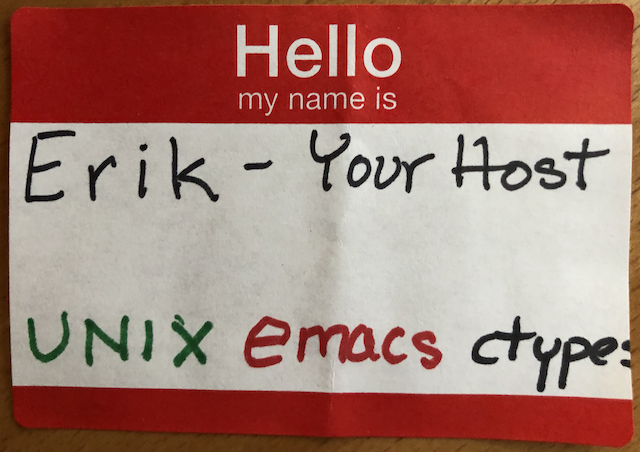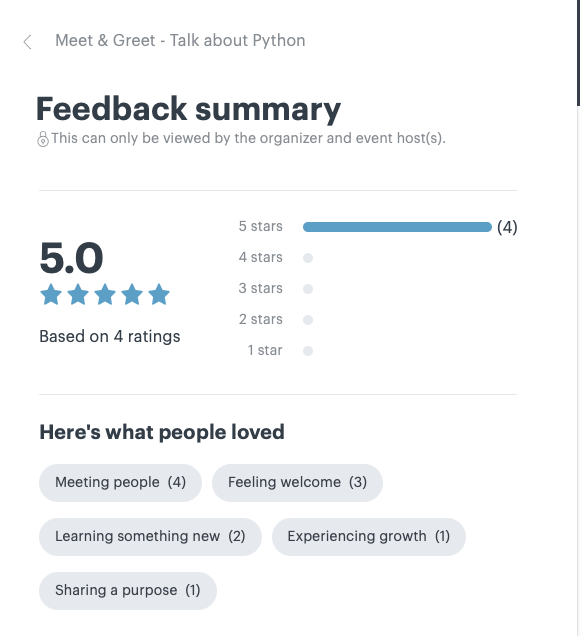How I Started a Python Meetup
Setting The Scene
I live just outside of Austin, Texas which is sometimes referred to as “Silicon Hills”. There are many large computer and technology companies here; IBM, AMD, Apple, Oracle, NVIDA to name just a handful. Just as importantly, there is a teeming ecology of smaller tech companies which provide goods and services across the entire gamut of the technology space. Austin is awash in nerds and geeks of every stripe.
Given all these talented people doing cool stuff, there are naturally meetups all over the greater Austin area where people get together, network and share their knowledge. I really wanted to attend the Austin Python meetup but their schedule and location wasn’t a good fit for me.
I was feeling sorry for myself, discussing the situation with a friend on the excellent PyBites Slack and he told me he’d just started a Python meetup. And he’d already had a meeting. I was gobsmacked and more than a little jealous of his initiative! I was motivated right there to stop waiting for the right meetup for me and make it happen.
What Have I Done?
It doesn’t take much to create a new organization on meetup.com. You are prompted for the following:
- A regional location
- An organization name
- Who the group is for.
Then they will ask you for money. To be honest, I did this late at night and the details on the cost are fuzzy. I signed up for a six month “subscription” and pushed the ‘Pay’ button. And then I thought to myself “Well great, now what?”.
If You Build It, Will They Come?
The next morning, I sat down and started digging into the tools provided by Meetup for groups. I hacked together a logo with the help of my exeedingly talented and patient wife and started branding the group meetup pages. I wrote some verbiage describing the kind of group I wanted to build and wrote some introductory text about myself.
When all was said and done, I spent maybe two hours on the graphic design and copy writing. The group page looked a little less generic and the text was ernest and forthcoming.
I spent some time discussing my efforts on Slack and received lots of positive reinforcement. Then I got my first notification from Meetup that someone had joined the group! Wow talk about a rush! I wasn’t entirely alone!
That weekend the membership increased steadily and I soon found myself with over 50 people interested in the group I proposed. Quick side note, once you get over 50 people in your group Meetup will want to increase the fee they charge. I blindly paid it, caught up in the excitement of creating a new community.
Ok, now it was time to get them to show up to a meeting.
The First Meeting
Meetups are notorius for creating a buzz around a topic, having a lot of people join up and then generating minimal attendence. I’m guilty of this myself. It’s pretty easy to click a button and say “Yeah, I’m kinda interested in that”. Re-iterating my introverted tendencies, it’s hard for me to work against personal inertia and show up to a meeting. And the little voice that whispers “they won’t like you” or “you’re not a real programmer” or “your socks aren’t alphabetized yet”. Two of those three thoughts really ocurred to me.
Having experienced this phenomenon myself, I wanted our first meeting to be more of a social setting than a technical one. So I picked my favorite upscale bar for the following reasons:
- Convenient to me geographically.
- I was comfortable there.
- Lots of room and table space for people to talk.
- Not crowded in the early afternoon on a weekend.
- Beer is a social lubricant.
I recognize that not everybody would be interested in adult beverages, but I am far more social after a pint of beer. Being in a comfortable setting let me be welcoming and open. It’s super tough to show up out of the blue and meet strangers, so my goal was to greet everyone with a smile and a name tag.
I crafted a meeting notice on Meetup and sent it out to the membership.
Preparation & Anticipation
I’m not going to lie. I was more than a little apprehensive about hosting a meeting. My very good reasons to be apprehensive included:
- No experience in running a group
- No experience hosting a meeting
- No experience running a meeting
While I spun my wheels grappling with my imposter syndrome, RSVPs started to come in. Actual people’s actual names now associated with the nebulous idea of a “python user group”. I needed to seriously put my act together and make something happen.
While I might not have experience at running a group, I definitely have been involved with different groups and I had ideas about the things that worked and didn’t work for all of them. I haven’t hosted a meeting, but I’ve attended plenty. I haven’t run a meeting, but I’ve been to good, bad and horrible ones. Working from past experience, I started preparing for the two hour meeting.
First, I knew I wanted those cheesy “Hello My Name Is:” stickers. I am terrible with names and I wanted to address any stressors in a new social situation. Knowing someone’s name is a great way to build rapport and the nametags smooth over those awkward seconds when you forget the name of the person you just met. It feels like the kernel of community to me.
Second, I wanted a clipboard because every “serious” organization has one (totally kidding, I just like clipbards). I found a cheap clipboard with integrated storage at the office supply store while looking for the nametags and sharpies and lamination materials. At home I printed out a 8.5x11” group logo, laminated it and taped it to the front of the clipboard. Now I had a sign to set out on a table and a “base of operations”. I also tucked in a couple dozen sheets of blank paper and pens.
Last, every fun computer group has a sticker for their laptop. At least as far as I know. I made a 2x3 inch design from my initial logo work and ordered a roll of 100 stickers from stickermule.com. Huge shout out to StickerMule for getting the stickers to me in time for the event!

The First Meeting
So you should probably contact your venue before scheduling your meetup. And you’ve probably already guessed that advice like that is hard won. I showed up thirty minutes early for the meetup, ordered a beer and talked to the staff. Bringing in sixteen customers on a slow afternoon will make any bar happy, but I had no plan B if they would’ve declined to host us. Lesson learned, call ahead.
I sat down and filled out my name tag. I wanted to give people some ice breakers, so I wrote my name, my favorite operating system, my favorite editor and an interesting python module.

As folks began to filter in, I invited them to fill out a name tag and introduced them around. Pretty soon, I had over a dozen people talking to each other about python, the computing industry and just hanging out. It was totally working!
My only goal for the meeting, beyond quaffing a beer or two, was to get some feedback on two things. First I wanted more ideas for places the group could meet. The bar is fine for a casual conversation, however everyone agreed it was too loud for a techincal discussion. And second, I wanted to find out what python topics people were interested in learning about.
Rather than interrupt the social flow with me pontificating, I bashed together two sheets; one labeled “Venue Ideas” and the other “10 Minute Python Talk Topics”. Those circulated through the group and at the end I didn’t have much in the way of venues (that’s a hard problem). But I did get a list of over a dozen python related topics that people were interested in learning about. That was huge. It gave me a guage of where people were at skill/experience wise and a roadmap for future meetings.
And Then It Was Over
The meeting lasted roughly two and half hours; thirty minutes longer than scheduled. I paid my tab and walked out with the last couple of people to leave. Everyone left with a sticker or two for their laptop and assurances that the next meeting would be somewhere quieter and have some actual python content. I was ridiculously happy with the meeting; people showed up, people talked and I got some feedback about the group and what other people were looking for.
Honestly, I am humbled and thrilled at the turn out for the first meeting. More than 90% of people who RSVP’ed attended and the anonymous event feedback was gratifyingly positive.

I talked to a bunch of genuine people who shared a common interest and I am really looking forward to seeing what comes next.
Next Steps
Our next meeting is tenatively scheduled for mid-November and I’ve announced a simple agenda; I’ll deliver a short 20-30 minute talk called “Python Crash Course” followed by 90 minutes of discussion and hacking. I’m already working on the materials for the talk. With any luck, I’ll have a quiet room that can accomodate 60 people.
If you can’t find a community that suits your schedule or needs, consider building one from scratch. In my sample size of two (1,2), there are people in the same position that are just waiting for you to step up and do it.